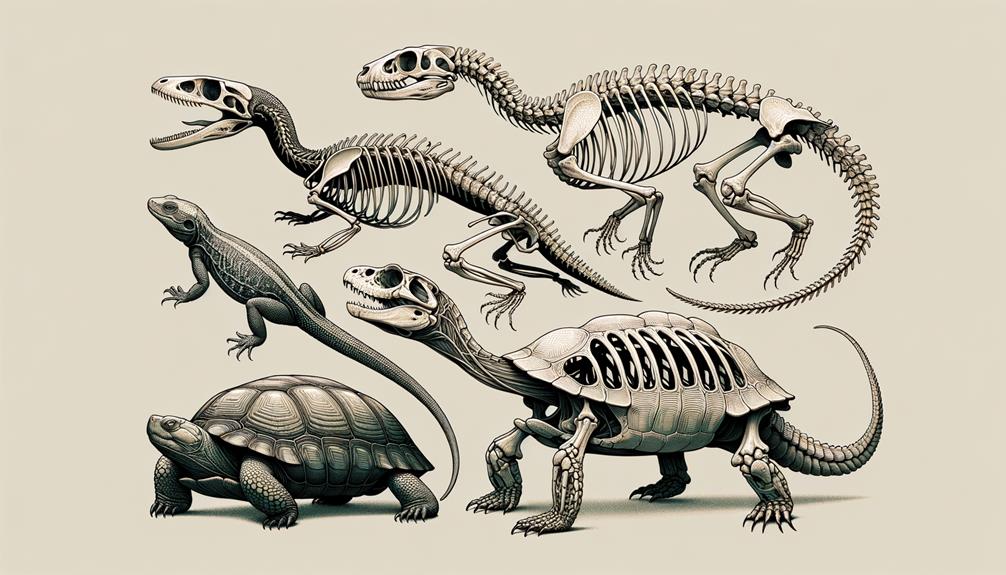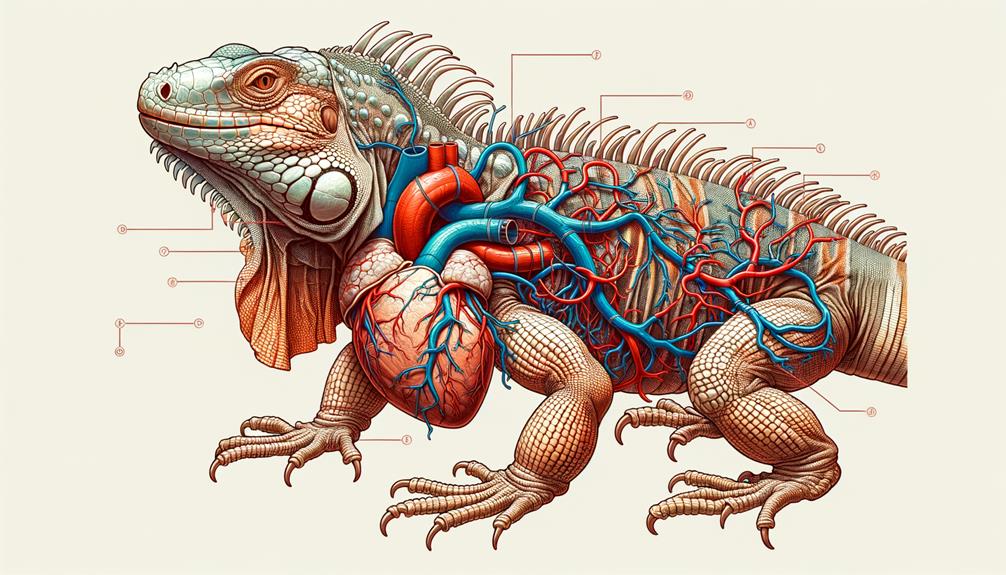Reptiles have evolved remarkable reproductive anatomy that's tailored to their diverse lifestyles. Their gonads, positioned in the coelom, optimize reproductive processes. In females, two oviducts connect to the cloaca, allowing for egg storage and fertilization. Males often have hemipenes, paired copulatory organs necessary for sexual reproduction. Many reptiles exhibit sexual dimorphism, with noticeable size and color differences that aid mate selection. They can either lay eggs or give live birth, depending on their environment. Environmental cues like temperature and photoperiod significantly impact reproductive cycles. Understanding these adaptations and their implications can provide valuable insights.
Key Takeaways
Reptiles have two oviducts connected to the cloaca, which facilitates fertilization and egg storage. Male reptiles have paired copulatory organs called hemipenes, a crucial feature for reproduction. Unlike mammals, reptiles lack a true uterus, making their reproductive anatomy distinct. The gonads are positioned cranially, optimizing reproductive efficiency and streamlined movement. Sex differences in reptiles include size, color patterns, and specialized reproductive structures.
Gonadal Structure
When examining the reproductive anatomy of reptiles, it's striking to see how their ovaries and testes are strategically positioned within the coelom. In many species, the right gonad is situated cranially to the left, particularly in snakes. This precise arrangement is no accident; it's an evolutionary adaptation that maximizes reproductive efficiency.
The coloration of these gonads varies greatly across species, ranging from vibrant yellow to a more subdued grayish-pink. This complexity adds another layer to their reproductive anatomy. It's clear that the location of these gonads is tailored to each reptile's unique physiology, ensuring optimal functioning within their reproductive system.
In snakes, for example, the positioning of the gonads likely aids in streamlined movement and efficient reproductive processes. The absence of a true uterus in reptiles further highlights their distinct reproductive strategies, setting them apart from mammals.
The intricate design of reptilian gonadal structure is a testament to nature's remarkable adaptability. By understanding these nuances, we gain a deeper appreciation for the delicate balance and precision inherent in reptilian reproductive anatomy. This exploration not only satisfies our curiosity but also highlights the remarkable adaptations that enable these creatures to thrive.
Oviducts and Cloaca
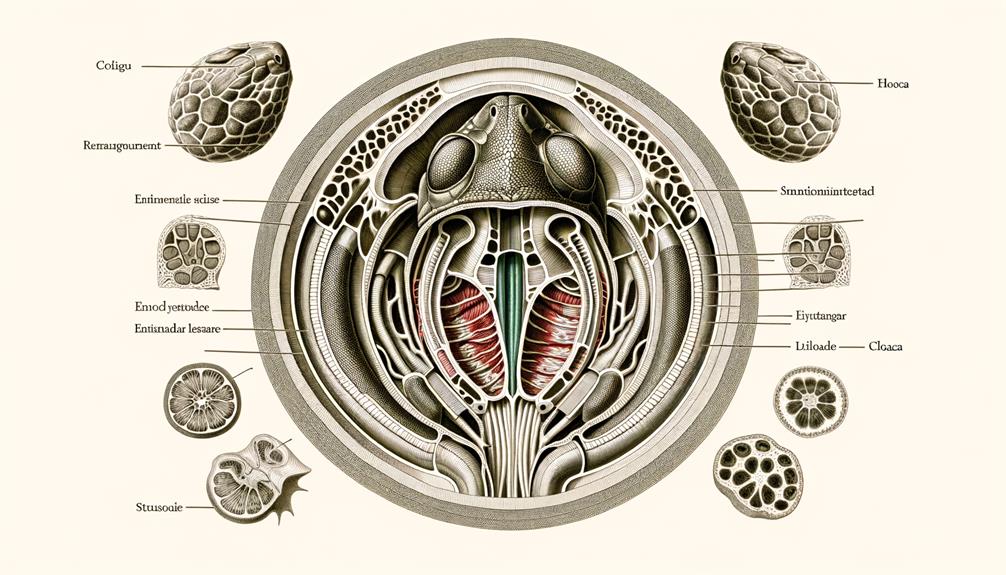
Building on our understanding of gonadal structure, let's dive into the crucial roles of oviducts and cloaca in reptiles' reproductive processes. In female reptiles, the reproductive tract features two oviducts – right and left – that directly connect to the cloaca via genital papillae. Unlike mammals, reptiles lack a true uterus, and instead, the oviducts serve as the primary sites for fertilization and egg storage. This adaptation enables them to lay shelled eggs, a vital feature for survival in diverse environments.
The cloaca, a shared chamber, is where the digestive, urinary, and reproductive tracts converge. This efficient design is not only fascinating but also crucial for reptiles' reproductive success. The direct connection between the oviducts and cloaca ensures that fertilized eggs can smoothly transition from the reproductive system to the external environment during oviposition.
This streamlined reproductive system highlights reptiles' remarkable adaptability, allowing them to thrive in various habitats. The absence of a distinct uterus and the pivotal role of the cloaca underscore their ability to reproduce successfully in a wide range of ecological niches.
Sexual Dimorphism
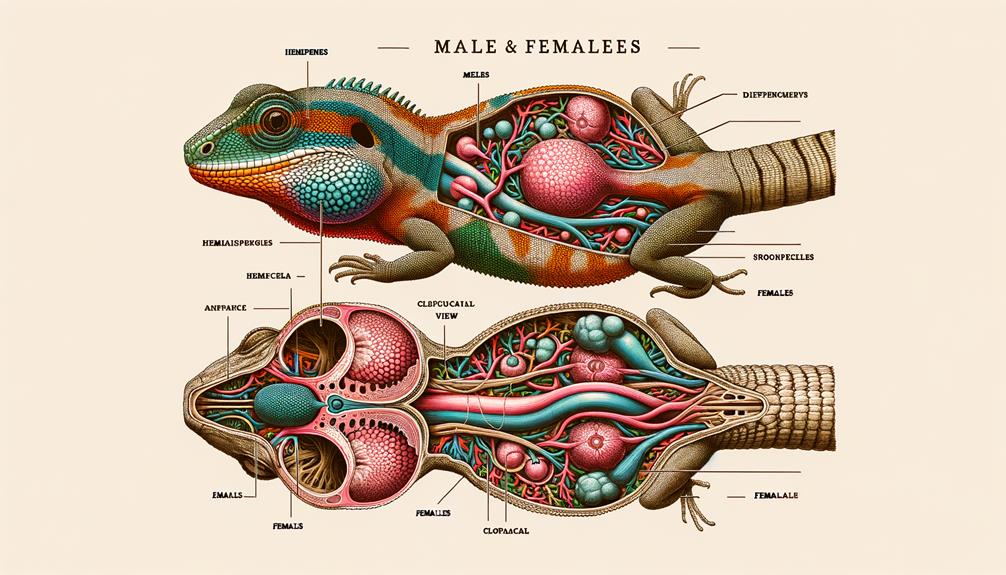
It's fascinating to explore the various ways sexual dimorphism manifests in reptiles, from size and coloration differences to the presence of specialized structures like hemipenes in males. These differences play a vital role in the reproductive success of these creatures. Hemipenes, the paired copulatory organs found in male reptiles, are a key feature distinguishing them from females. The degree of sexual dimorphism varies significantly across species, contributing to the remarkable diversity we see in the reptile kingdom.
Consider these interesting points:
- Size Variations: In many species, males tend to be larger, which can be advantageous in territorial disputes and attracting mates. This size difference can be a key factor in determining reproductive success.
- Coloration and Markings: Distinct patterns and vibrant colors often serve as visual cues to identify sex, aiding in mate selection and species recognition. These visual cues can be crucial in ensuring successful reproduction.
- Specialized Structures: Hemipenes are a notable example, functioning effectively during mating to transfer sperm to the female's cloaca. This unique structure is essential for the reproductive process in many reptile species.
- Embryo Moisture Management: Females often have adaptations for ensuring the embryo remains moist, which is essential for the development of healthy offspring. This adaptation is critical for the survival of the species.
Understanding these differences not only expands our knowledge but also deepens our appreciation for the remarkable evolutionary adaptations that define reptilian life.
Egg-Laying Vs. Live-Bearing
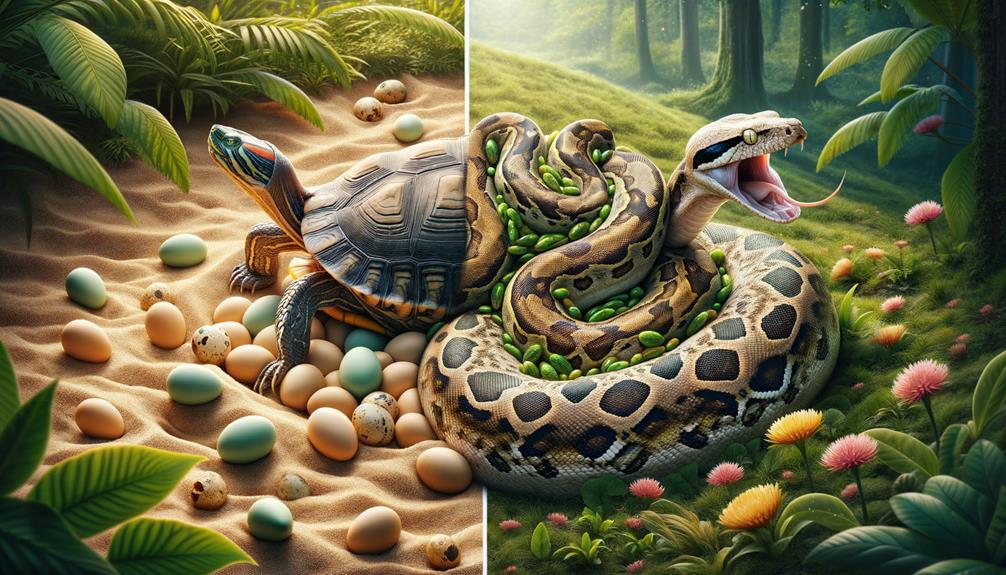
Delving into the reproductive strategies of reptiles, we find a fascinating contrast between egg-laying and live-bearing. Reptiles that lay eggs, like most lizards and snakes, need to find a constantly moist environment to incubate their eggs. This approach requires minimal parental care, allowing them to conserve energy for future reproduction.
On the other hand, some reptiles, like certain snakes and lizards, retain their eggs inside their bodies until they hatch. This method provides additional protection and nourishment to their developing offspring, especially in unpredictable environments. Although this approach comes with higher energy costs and mortality risks for the female, it increases offspring survival rates.
What's interesting is that some reptile species can exhibit both egg-laying and live-bearing individuals within the same population, highlighting their adaptability in reproductive strategies. These diverse approaches demonstrate the intricate balance of evolutionary pressures in reptilian reproductive biology.
Environmental Influences
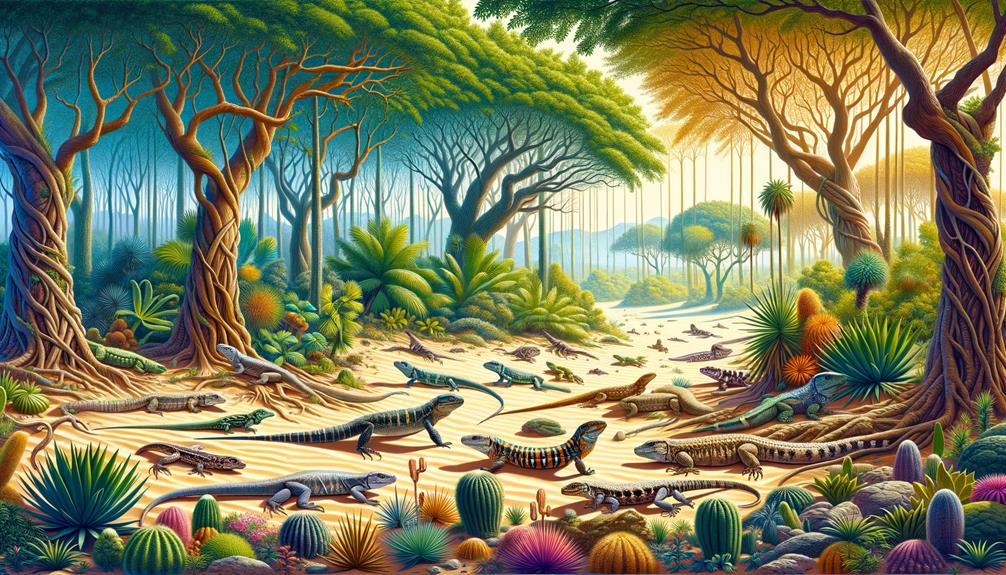
Environmental factors have a significant impact on the reproductive behaviors and success rates of various reptile species. To understand these influences, it's essential to explore the natural history of these fascinating creatures. For example, day length, or photoperiod, acts as a primary cue for initiating reproductive activities. Longer days signal to many reptiles that it's time to breed, aligning with the most favorable conditions for offspring survival.
Temperature is another critical factor that directly affects the rate of gonadal development and ovulation. Warmer temperatures often accelerate these processes, while cooler climates may delay them. Changes in rainfall and humidity also play a significant role. Increased moisture can prompt reproductive behaviors and egg-laying, as many species rely on specific environmental conditions for successful reproduction.
Environmental stressors, such as habitat disturbance or captivity conditions, can disrupt normal reproductive patterns. On the other hand, food availability and nutritional status are key determinants of reproductive success. Well-nourished parents provide better care and invest more in their offspring.
- Photoperiod: Triggers reproductive timing.
- Temperature: Affects gonadal development and ovulation.
- Rainfall/Humidity: Induces reproductive behaviors and egg-laying.
- Food Availability: Regulates reproductive investment and success.
Reproductive Disorders

In addressing reproductive disorders in reptiles, common issues like dystocia, metabolic bone disease, and oviductal prolapse pose significant health risks. To identify these conditions early, diagnostic techniques such as radiography and ultrasonography are crucial. Effective treatment and management strategies, ranging from surgical interventions to dietary adjustments, can greatly improve outcomes for affected reptiles.
Common Reproductive Issues
Reproductive Challenges in Reptiles
Dystocia, or egg-binding, is a critical issue that requires immediate veterinary attention. This condition occurs when eggs become trapped in the oviduct, putting the health of both the mother and the developing fetus at risk. Nutritional deficiencies, such as those seen in metabolic bone disease, can worsen this problem by affecting egg production and shell formation.
Reptiles often face other reproductive issues, including:
- Prolapsed cloaca, where parts of the digestive, urinary, and reproductive tracts protrude from the body. This condition requires immediate veterinary intervention to prevent further complications.
- Neoplasia, or cancerous growths in the reproductive organs, which can lead to infertility. Surgical removal is often necessary to ensure the reptile's health and ability to reproduce.
- Reproductive tract infections, such as metritis and salpingitis, cause inflammation and can severely impair breeding success. Antibiotic treatment is necessary to address these infections.
- Metabolic bone disease, which not only affects the skeletal system but also impacts reproductive health by compromising egg quality and production, leading to dystocia.
Promptly addressing these issues is crucial for securing a healthier life for reptiles and successful breeding outcomes.
Diagnostic Techniques Employed
Understanding reproductive disorders in reptiles requires a comprehensive approach that combines both invasive and non-invasive diagnostic techniques. Dissection and endoscopy allow for direct examination of internal reproductive anatomy, providing valuable insights into morphology and developmental stages. While these techniques are invasive, they offer unparalleled information about the physical state of reproductive organs.
Non-invasive imaging techniques like radiology, ultrasound, and CT scans provide a less intrusive way to visualize internal reproductive structures. These techniques are crucial for monitoring and evaluating developmental changes over time, and can reveal abnormalities without the need for surgical intervention.
Blood chemistry analysis, focusing on hormone measurements, is another essential tool. By studying hormonal fluctuations, researchers can gain significant insights into the reproductive status and cycles of various reptile species. This method is particularly useful for understanding the physiological underpinnings of reproductive behaviors and disorders.
Intramuscular hormone injections can stimulate or induce reproductive behaviors, offering a practical way to study reproductive physiology and behavior in a controlled manner.
Diagnostic techniques employed include:
| Technique | Purpose |
|---|---|
| Dissection and Endoscopy | Direct examination of internal reproductive structures |
| Radiology, Ultrasound, CT | Non-invasive visualization and monitoring of reproductive organs |
| Blood Chemistry Analysis | Insight into reproductive status and cycles through hormone levels |
| Hormone Injections | Induction and study of reproductive behaviors and physiological processes |
| Ethical Consideration | Ensuring humane treatment and adherence to animal welfare guidelines |
It is essential to consider ethical implications when conducting research, ensuring that it is conducted humanely and responsibly.
Treatment and Management Strategies
Effectively managing reproductive disorders in reptiles requires a multifaceted approach that combines prompt veterinary care, nutritional support, and careful monitoring of physiological parameters. One of the most critical issues, dystocia or egg-binding, demands immediate veterinary attention to prevent severe complications. Providing essential nutrients like calcium and vitamins during reproductive periods is vital for the health of both the female and her developing offspring. Regular monitoring of hematology and blood chemistry changes is crucial, as it provides valuable insights into reproductive status and helps detect underlying problems early.
To ensure comprehensive care, consider the following strategies:
- Prompt Veterinary Care: Address any signs of reproductive distress quickly to prevent them from escalating into more severe conditions.
- Nutritional Support: Regularly supplement diets with essential nutrients like calcium and vitamins to support reproductive health.
- Monitoring Physiological Parameters: Frequently check bloodwork to identify any abnormalities that could indicate reproductive issues.
- Stress Reduction: Handle reptiles gently and carefully to minimize stress and the risk of zoonotic disease transmission, which can exacerbate reproductive disorders.
Veterinary examinations, combined with imaging techniques like radiography and endoscopy, are essential tools for evaluating the reproductive tract's health and functionality, ensuring targeted and effective management strategies.
Frequently Asked Questions
What Are the Three Kinds of Reproduction Seen in Reptiles?
Reptiles exhibit three main types of reproduction: oviparous, where they lay eggs; ovoviviparous, where eggs hatch inside the female's body; and viviparous, where young develop fully inside the female and are born alive.
What Are the Male Reproductive Structures of Lizards and Snakes?
Male lizards and snakes have a unique way of reproducing. They use hemipenes, which are paired organs that emerge during mating. Each hemipenis has distinct features, such as spines or hooks, that help increase reproductive success. Once mating is complete, the hemipenes retract back into the body.
How Do Reptiles Reproduce Asexually?
Reptiles can reproduce asexually through a process called parthenogenesis, where females produce offspring without male fertilization. This unique ability allows them to maintain genetic continuity in isolated environments, which is pretty fascinating. It's amazing how nature has developed diverse strategies to ensure survival.
What Is Lizard Reproductive Process?
Did you know that female lizards have the remarkable ability to store sperm for up to seven years? They reproduce sexually through internal fertilization, often accompanied by intricate courtship displays. In some species, they can even reproduce asexually through parthenogenesis, which is a fascinating reproductive strategy.


